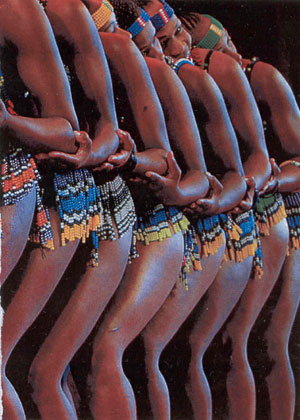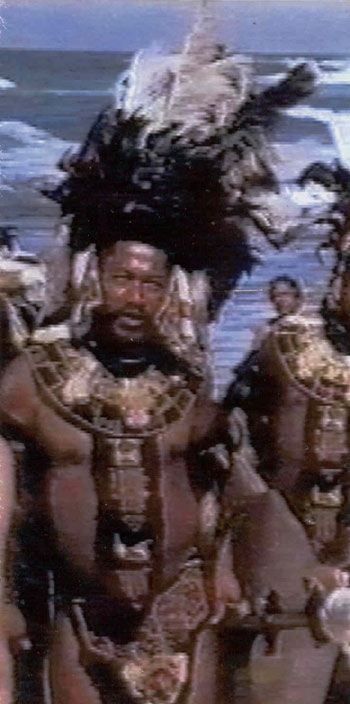Rhombuses symbolizing snake skin for warding off Evil....

A big rhombus (diamond, lozenge) on the floor of the theater of Dionysos (rattle snakes have diamond backs).

Rhombus above the door at Chartres (Notre Dame Cathedral Church). 13th century.

Rhombuses in village of Santorini Island (village of Karterados, October 2000) .
Beads for skirts, for bands(forehead and breast)and for good-luck bringing rhombuses....

Moccasins, c. 1800. Beaded hide.Wyoming. The North-American Indian also used multicolored beads to make shoes, belts, hats and necklaces and the beading is one of many similarities that bring close the Indians and the Zulu.

Beaded bands for the forehead and short skirts for the famous Zulu girl dancers. "They traded the beads with the Arabs (cattle for beads)" and even earlier.

A tall and blond lady from S. Africa had attached this rhomb to her dress and she gave it to me when I told her that I study the Zulu, It is made of multicolored beads.

Folk Art of Mexico.

Rhombuses at the entrance of a house at Lisboa, Portugal.

Rhombuses and rhomboid pattern on the wall of a house in China. When traveling in the province of Sichuan I saw so many rhombuses on the wall of houses (something common in Greece), rhombuses decorate American Indian necklaces and belts and our woolens, today.
Babies carried on the back......

W.Africa. Cape Verde. On the bag carrying the baby rhombuses in blue-turqoise (double protection).

A young Chinese mother carrying her baby on the back.

Epirus, loannina. 1941, during World War II. Photo "Kathimerini".
Elephant tusks......

Shaka surrounded by elephant tusks and rhombuses. He was called "The big elephant".

Elephant tusks on either side of skulls (of enemy Kings) hang outside Shaka's village.
The "hair of Apollo....

Ivory head of Apollo "with long hair" in the Museum of Delphi. His hair though is shown only above his forehead (gold leaf attached on the ivory) and probably, the gold bands to the left and to the right is the memory of elephant tusks. Most probably he was wearing a crown.

In a Temple of Taiwan Qing Shui Tsu Shih, God of Anshi people of Fukien Province, has long "bands" like Apollo and wears a crown.

Chinese Empress with the same "bands".

Taiwan Opera actor.
Snakes coiled around the arms like around tree branches....


Ivory and gold statuette (16,5 cm.) from Knossos. About 1,500 BC. Boston Museum of Fine Arts.


Feathers on the head for the Zulus, the Chinese, the Greeks and ring-snakes around the arms.....

Shaka's official with the Pharaonic collar-snake.

"Rings"around his arms symbolizing a coiled snake.

"The prince of the lilies", with pheasant feathers. Wall-painting of Cnossos about 1,600 BC in the Herakleion Museum.

Yao'An people with pheasant feathers..

A Prince on his chariot.

Paiwan (one of the aboriginal tribes of Taiwan) youth who won, one feather, the third prize in a foot-race. His brother won the first prize, three feathers.
Symbolic snake patterns on poles and columns.....

Patterns with snake symbolism on columns inside Shaka's hut. He was sleeping on the floor on a straw mattress and leopard skins.

Totem poles of the Yi minority of China with similar "geometric patterns".
Body painting with symbolic snake patterns. Parallel lines for people, animals and vases.....

Body painting practiced by the Yanomamis of Brazil and Venezuela (Amazonius). The Yanomamis of Northern Brazil are the most primitive of all aboriginal tribes of Brazil Photo Artaud.

Clay statuette (H. 16 cm.) from Sesklo (Thessaly). About 3,500 BC. Athens Archaeological Museum.

Masked dancers from southern Zaire (Pende).

Peru aboriginal with snake pattern (rhombus) on the forehead. Photo Artaud.

The doctor-magitian puts medicine on the wound of Shaka's father. All his body is painted with symbolic snake design.

Australian aborigine. Photo KATHIMERINI, July 8, 2001*

Mbwela people, the neighbors of the Zulus.

Australian dance (Cape York) with painted snake patterns on the body and feathers on the head.

Painted ceramics of Gansu H.27cm.3rdmill.BC. Paris Cernushi Museum.

Minoan clay horse "decorated with vertical and oblique bands". Herakleion Museum.
Lion's hair or ox-tails?

The male lion, "the king of the animals." With the hair of its mane the Zulu will decorate their breast, waist, arms and legs. The older the lion, the longer its hair.


Shaka playing with lion's hair like with worrying beads.

Hercules killing a lion with his bare hands on a red-figured vase (British Museum). The Massai of Kenya during initiation rites to prove their manhood and become warriors had to go alone out into the bush and kill a male lion with their bare hands.
Dancing in New Kaledonia and in the Zululand.....

Dance of a kanak ceremony on a threshing floor in New Kaledonia. with straw skirts and head-wreaths with braids. The dancers are warriors with terrifying faces and javelins and axes. They danced for days and weeks.

Wild war dance.

A dancer with tattoo marks.

Exactly like the New Kaledonians, the Zulu and their neighboring tribes wore similar straw skirts and wreaths with long straw braids.

Angola and Congo initiation rites. Photo Internet.

Photo from the book "Shaka" by Diane Stanley and P.Vennema. The fringes around the arm Ballet dancers will wear up to now. The fringes were made of manufactured ox-tails.

One of Shaka's generals with his club. With such clubs the Zulus used to kill the enemy and also lions, leopards and snakes. On his breast hanging ox-tails.

The walking stick of the Greek-orthodox bishop is similar to the club of Hercules and of the Zulu.

Zulu dancer with dancing stick and straw decoration

New Kaledonian dancers with painted symbolic patterns on their body and straw skirts and fringes around the arm.

Tikuna Indian mask used in puberty rites made of beaten bark of the Ficus tree. Photo Internet.

The Tikuna Indians "reside in the Brazilian Amazon rain forest near the borders of Peru and Colombia. Their traditional festival attire is with feathers and fibers of beaten bark of the Fig tree".
The fan of the Kiroff Ballet Theater, of the Taiwanese aborigines and of Dulcinea...

Zulu girls dancing in short skirts.

Aborigines of Taiwan dancing and holding fans. Dulcinea (Don Quichote) also holds a fan.

S. Korea. Village of Hahoe. The famous Pyolshin-gut masked dance.